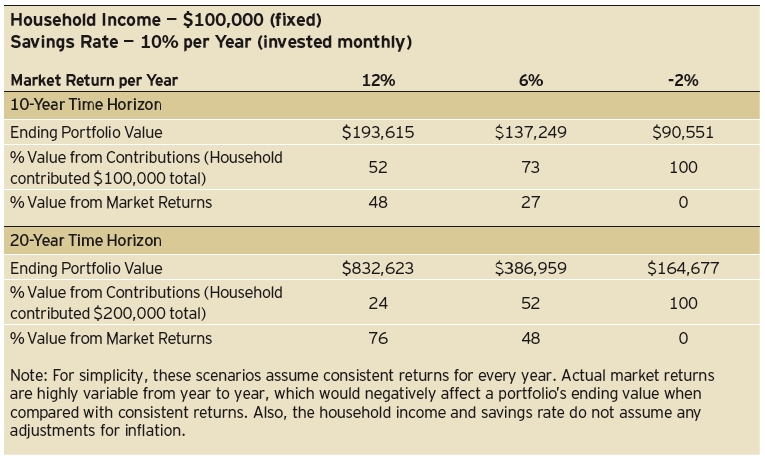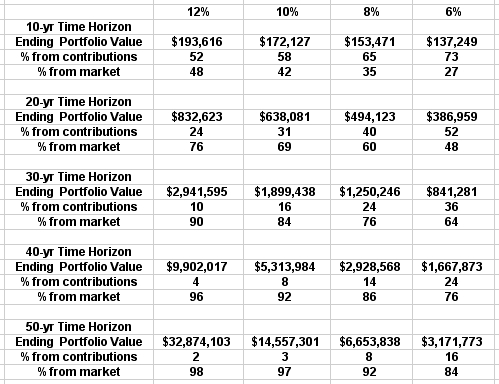This was the question posed on a Morningstar article a couple weeks back. It begins by offering the fact that the bull market of the eighties set the stage for high expectations, specifically that the market would make you rich even with a small sum invested. It closes with this punchline; “Here’s the reality: Your contributions matter much more than investment returns.” Within the article appears the following chart. It assumes an annual deposit of $10,000 invested monthly over the stated time horizons and given rates of return.
 The logic behind the article centers around the ratios calculated above. With an annual return of 6%, (I’ll ignore the 12, as I don’t expect to see 12 long term) you can see that over a ten year period, the value of the account is 73% from deposits, and 27% from growth, the market’s return. Over a 20 year period, with the initial deposits having longer to grow, the ratio is now 48% from gr0wth. This is where the article stops and concludes with the “control what you can” advice. I am 47 years old, and have been working since I’m out of college, 25 years now. Even if I retire early, my money is still invested, so at 62, I’ll have a 40 year investing history, and after retirement a couple more decades, I’d hope. So, why not extend this chart a bit?
The logic behind the article centers around the ratios calculated above. With an annual return of 6%, (I’ll ignore the 12, as I don’t expect to see 12 long term) you can see that over a ten year period, the value of the account is 73% from deposits, and 27% from growth, the market’s return. Over a 20 year period, with the initial deposits having longer to grow, the ratio is now 48% from gr0wth. This is where the article stops and concludes with the “control what you can” advice. I am 47 years old, and have been working since I’m out of college, 25 years now. Even if I retire early, my money is still invested, so at 62, I’ll have a 40 year investing history, and after retirement a couple more decades, I’d hope. So, why not extend this chart a bit?
Note, I took out the potential 2%/yr loss. It stands to reason that with zero or less return, all of your return is from deposits. I did add a column for 8% and 10% as the long term stock returns fall closer to this range. A thirty year time horizon really starts to change things, doesn’t it? At 30 years you can see that 64% or nearly 2/3 of the ending account value is from growth, and only 1/3 from deposits. The numbers are even more skewed at higher returns or longer time horizons.
What to conclude from this? First, whenever you read anything regarding a long time span, take it with a grain of salt. Second, even a small difference in returns, just 2%, will dramatically affect your returns over a sufficiently long period. Last, and most important, you need to understand your own risk tolerance, I included the 12% column as it was part of the original article, but with reward comes risk, don’t count on that kind or return when you plan your retirement 30 or 40 years hence.
(If the link to Morningstar doesn’t function, the article is available from Invesco Aim)
Joe


Your contributions i.e. 401K contributions matter more only up to a certain point. That point is probably around $200,000 where your performance matters more. Why? $16,500 is only 8% of your total. The long run market return is around 8%, so that is your break even.
Once you get over $200,000, what matters most is your performance, b/c in this downturn, $16.5k contribution this yr didn’t do diddly
Another spin, I like that. It’s also why my current savings no longer puts a huge dent in the total. The first 25 year really mattered. Now it’s the market return that matters more to me.
Yep, that’s why so many people say “wow, this recession hasn’t hurt me one bit!” It’s because these folks probably have only $50,000 or less in their 401k or investment portfolio, so down 50% to $25,000 but up 60% to $42,000 + $16,500 in contributions = Wow, I have $58,500 now! 🙂
Just goes to show that even just one large “Black Swan” negative event can do quite a bit of damage to portfolios that are at a certain stage.
There is one small problem with this analysis. It ignores inflation.Even an 8% return is reduced to about zero after inflation is calculated. This post explains why.
http://www.onlineinvestingai.com/blog/2009/03/30/the-hidden-danger-of-inflation/
Another issue that this analysis ignores is emotion. All of our decision making is done with our emotions. Most people cannot stand the pain of seeing their life savings drop 50%, 60% or 90%. Yet, most people who invest for 50% will see this happen to their portfolio.